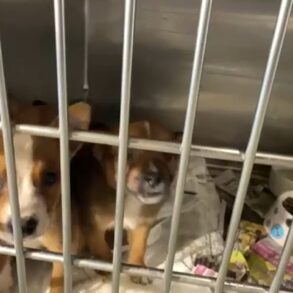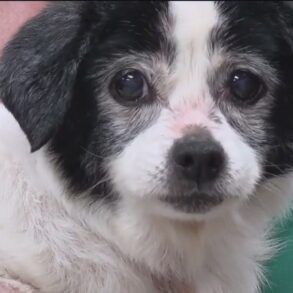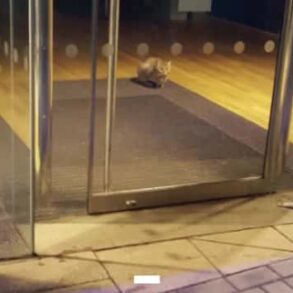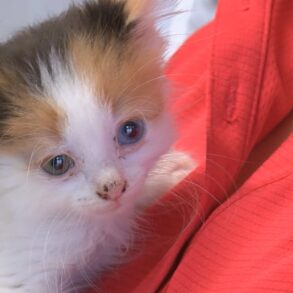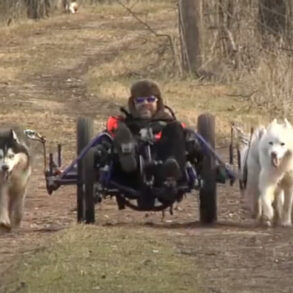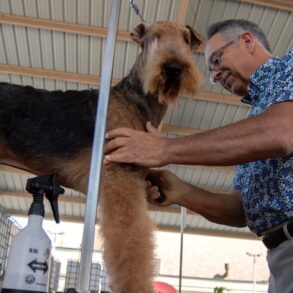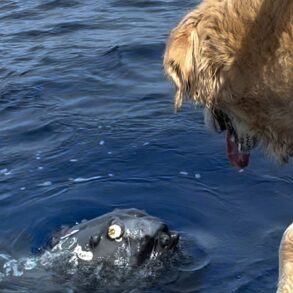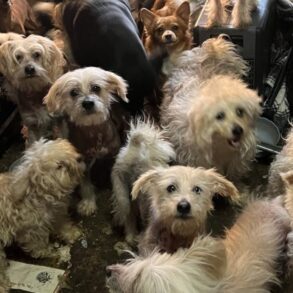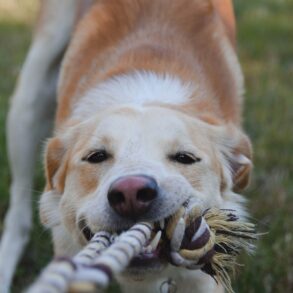Steven Wesselink loves his three Skye terriers: Sybil, Dot and Faith.
According to Mr Wesselink, who is the vice-president of the British Terrier Club of NSW, the breed’s short legs, long fur and gentle temperament create a “gorgeous” dog.
“They’re such a sweet, calm, quiet terrier,” he says.
“Most terriers are quite active and vibrant. The Skyes will just stand there and give you a kiss.”
Without an increase in numbers though, the breed could be headed towards extinction.
Loading…
This hasn’t always been the case. In the 1878 book The Dogs of the British Islands, the author suggests that the Skye terrier was bred on the west coast of Scotland “for the pursuit of vermin”, whereas in England, it was “very fashionable as a lady’s pet”.
Queen Victoria even had a few Skye terriers — Islay, Dot, Cairnach and Dandie.
But today, Skye terriers are one of the rarest dog breeds in the UK and Australia.
There’s a chance they’ll join the Old English Bulldog and New Zealand Kurī on the list of dogs that have died out.
Because while humans have been breeding dogs for thousands of years, not all have survived to the present day.
And causes for extinction vary from fashion trends to reasons that are much more sinister.
‘Vulnerable’ breeds are surprisingly common
While all dogs — big and small — are one species of animal, breeds are types of dogs bred for different purposes or looks.
Some, like the Skye terrier, have existed for hundreds of years, but “breeds” as determined by kennel club organisations didn’t start until the 1800s for use in dog shows.
These dogs have a specific set of physical and behavioural traits and can be traced back through a genetic lineage.
Steven Wesselink’s three Skye terriers – Sybil, Dot and Faith. (Supplied: Steven Wesselink)
Today, more than 300 pedigree breeds of dog are recognised by kennel clubs around the world.
In Australia, the top dozen pedigree breeds might have thousands of births and registrations in Australia every year.
For instance, golden retrievers and staffies add up to almost 10,000 of the pedigree dogs born and registered annually here.
But most breeds have less than 100 registered births each year.
Last year, the Skye terriers had just 15 registered births across Australia, and 70 in the UK.
The Kennel Club in the UK keeps track of native dog breeds with less than 300 registered births per year as “vulnerable”, and the Skye is on the list with 38 others.
While it’s unknown exactly how many Skye terriers are born each year worldwide, the Australian and UK numbers suggest their numbers remain low.
“Our vulnerable native breeds originate from the UK and Ireland and these figures paint a picture of how these breeds have declined over the years in their native country,” a spokesperson for the Kennel Club told the ABC.
One of those breeds was the Paisley (or Clydesdale) terrier. It was closely related to the Skye terrier, but had a longer, silkier coat.
The late 1800s were the breed’s heyday, but by the 1920s its numbers had drastically waned due to its unpopularity in dog shows.
By the middle of the century, the breed was extinct.
Lost jobs lead to breed extinctions
Sometimes a breed will die out because it’s high maintenance. Other times, they disappear because they’re no longer useful.
Whether it’s scouting for trouble, helping hunt other animals, or going into battle with us, there are plenty of jobs dogs did that were once considered vital, but are now largely relics of the past.
The otter hound — with only 40 births recorded in the UK and two in Australia last year — is one of those dogs that are rare due to a loss in function.
Otter hounds, as the name suggests, are a type of hunting dog that was bred to be used in packs to hunt and kill otters. While the breed was always relatively rare, their numbers plummeted when otter hunting was outlawed in the UK.
Otter hounds still look very similar to this carving done in the 1880s. (Supplied: The Dogs of the British Islands/A Baker/Public Domain)
Many breeds of dogs used for blood sport — such as the Old English Bulldog, which was bred for bull baiting and dog fighting — went extinct when those pastimes were outlawed.
Another dog that disappeared due to job loss was the turnspit dog.
It was a long dog with short legs, similar to a dachshund, but strong enough to run on and turn a heavy wheel.
The wheel turned meat cooking over a fire, hence the breed’s name.
Turnspit dogs would work inside a wheel near the ceiling multiple days a week. (Wikimedia Commons: Henry Wigstead/Public Domain)
Not much is known about the turnspit, as they were seen as lower-class working dogs, but they were used for much of the 17th and 18th centuries.
Over time, mechanical spit turners took the place of turnspit dogs, and by the time The Dogs of the British Islands was published in 1878, the author suggests they were “almost or quite extinct”.
Effects of colonisation
As people colonised parts of the world, they changed the genetics of those places — not just the human inhabitants, but also dogs, according to Angela Perri, a University of Durham archaeologist specialising in dogs.
“Across the archaeological record, [there are] times where a human population and a dog population move into an area and very quickly take over genetically,” she said.
One example is the Salish Wool Dog. It was a dog bred by the Indigenous Coast Salish peoples in North America.
Salish wool dogs were sheared like sheep to get their fur to make yarn. (Wikimedia Commons: Paul Kane/Public Domain)
Their white, wool-like fur was used to make textiles such as blankets. These blankets were also woven with plant fibres, feathers and mountain goat fur, and were of huge cultural significance.
But according to Dr Perri, this distinct and important dog breed quickly went extinct when Europeans arrived.
“We know from historical context, that European colonisers … had quite negative feelings towards Native American dogs, and were intentionally trying to snuff out these dog populations,” she said.
“They thought they were quite nasty dogs, they didn’t want their European dogs breeding with [them].”
Similar stories exist across the Pacific.
The ancestors of Polynesian people brought their dogs with them as they settled across the Pacific Islands.
Kurī now only exist in museums after being bred out of the dog population. (Wikmedia Commons: Kane Fleury/Otago Museum/CC BY 4.0)
Some breeds, such as the Kurī in New Zealand, were used to hunt, and were an important source of food and skins.
But once Europeans arrived, their dogs did too, and interbreeding caused the Pacific Island breeds to go extinct.
‘Variety is the spice of life’
Once a breed is gone, it’s not possible to bring it back exactly the way it was.
As breeds become rarer their gene pool gets much smaller putting of them at risk of reaching a point where there is no return.
Skye terrier Archer won the terrier group in the prestigious 2025 Westminster Kennel Club Dog Show in the US. (Reuters: Eduardo Munoz)
Maintaining numbers of vulnerable breeds will help ensure existing populations have enough genetic diversity, the UK Kennel Club spokesperson said.
“Smaller populations have lower genetic diversity, which can increase the risk that certain health conditions will begin to surface.”
For Mr Wesselink, a reason to protect breeds such as his beloved Skye terriers from extinction is simpler: “Variety is the spice of life.”
Check out What the Duck?! presented by Dr Ann Jones to hear about how we got from wolves to pugs, and subscribe to the podcast for more.
This post was originally published on this site be sure to check out more of their content.







